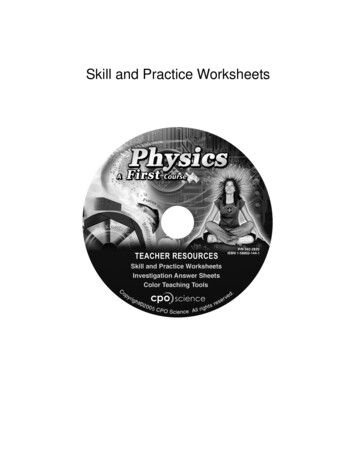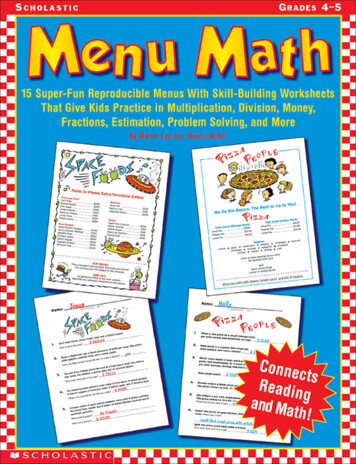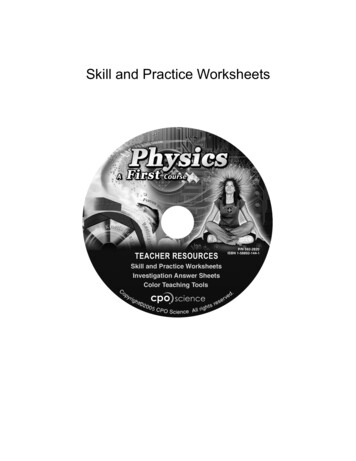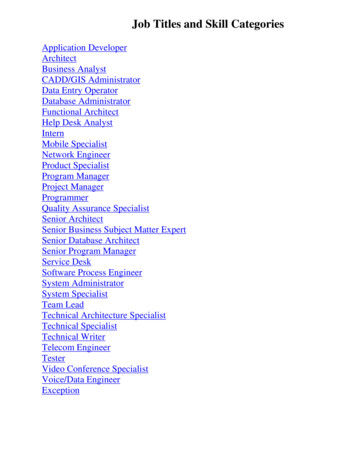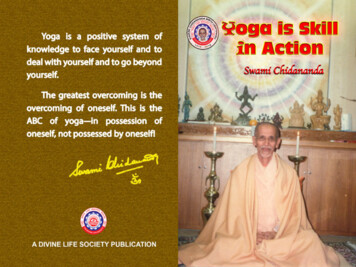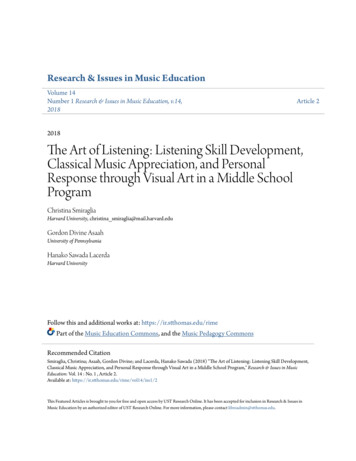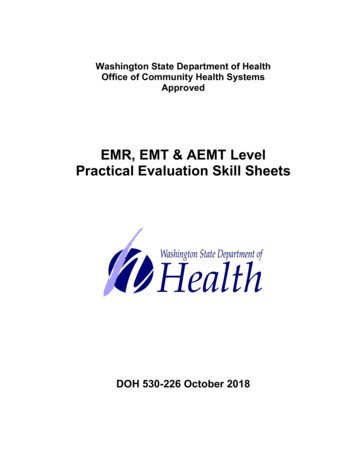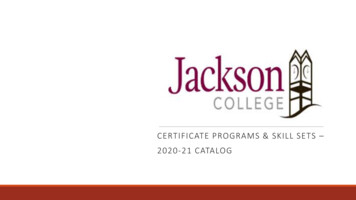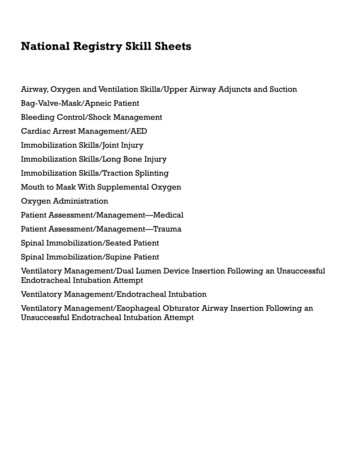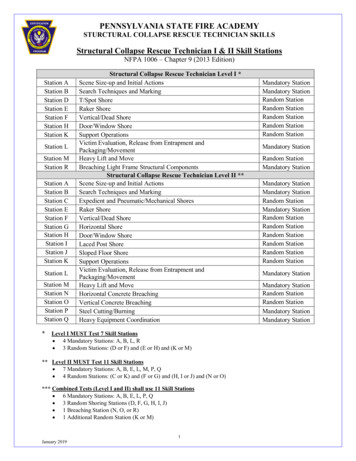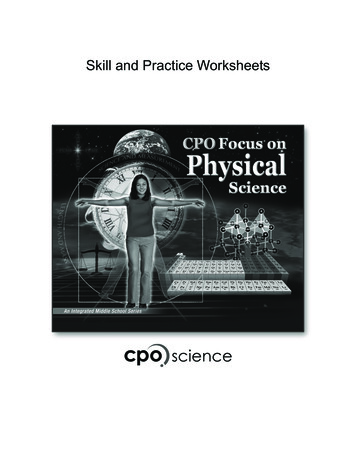
Transcription
Skill and Practice Worksheets
CPO Focus on Physical ScienceSkill and Practice WorksheetsCreditsProject Manager and Principal WriterLaine IvesWritersScott W. EddlemanMary Beth Abel HughesErik BentonPatsy EldridgeTom HsuMary Ann EricksonSonja TaylorCatherine ReedKelly StoryLaura TierneySharon FaulknerBeverly VissoeMelissa VelaJill ElenbaasLisa LaverdiereJames SammonsFran Lyons SammonsBecky PorterStacy KisselLeslie Sheen - Graphic OrganizersPatricia TremblayGraphic ArtistsPolly CrismanJesse Van ValkenburghBruce HollowayCopyrightCPO Focus on Physical ScienceTeacher’s Resource CD 12007 Delta Education LLC, a member of the School Specialty FamilyISBN-10: 1-58892-297-9ISBN-13: 978-1-58892-297-7All rights reserved. No part of this work may be reproduced or transmitted in any form orby an means, electronic or mechanical, including photocopying and recording, or by anyinformation store or retrieval system, without permission in writing. For permission andother rights under this copyright, please contact:CPO Science80 Northwest BoulevardNashua, NH d in the United States of America
Contents1.1: Using Your Textbook4.2B: Buoyancy1.2A: Stopwatch Math4.2C: Archimedes’ Principle1.2B: SI Units6.1A: Ernest Rutherford1.2C: SI-English Conversions6.1B: Niels Bohr1.2D: Dimensional Analysis6.1C: Marie and Pierre Curie1.2E: Reading Strategies (SQ3R)6.1D: Rosalyn Sussman Yalow1.3A: Study Notes6.1E: Atoms, Isotopes, and Ions1.3B: James Prescott Joule6.2A: Albert Einstein2.1A: Creating Line Graphs6.2B: Structure of the Atom2.1B: Measuring Angles with a Protractor8.2A: Dot Diagrams2.1C: Solving Equations with One Variable8.2B: Chemical Formulas2.1D: What’s the Scale?9.1: Calculating Concentration ofSolutions2.1E: Internet Research Skills2.2A: Averaging2.2B: Preparing a Bibliography2.2C: Scientific Processes2.2D: Percent Error2.2E: Significant Differences inMeasurement10.1: Chemical Equations10.2A: Lise Meitner10.2B: Predicting Chemical Equations11.1: Classifying Reactions12.1: Position on the Coordinate Plane12.2A: Dimensional Analysis3.1: Science Vocabulary12.2B: Velocity and Speed3.2A: Temperature Scales12.3A: Analyzing Graphs of MotionWith Numbers3.2B: Specific Heat4.1A: Density4.1B: Slope from a Graph4.2A: Archimedes12.3B: Analyzing Graphs of MotionWithout Numbers12.3C: Calculating Slope from a Graph13.1A: Chien-Shiung Wu
13.1B: Mass versus Weight13.2: Equilibrium14.1: Isaac Newton14.2A: Applying Newton’s Laws of Motion14.2:B Acceleration14.2C: Newton's Second Law15.1A: Ratio and Proportions15.1B: Nicolaus Copernicus15.1C: Galileo Galilei15.1D: Johannes Kepler15.1E: Benjamin Banneker15.1F: Touring the Solar System15.1G: Gravity Problems16.1A: Scientific Notation16.1B: Arthur Walker16.1C: The Sun: A Cross-Section16.1D: Understanding Light Years16.1E: Calculating Luminosity17.1: Edwin HubbleAnswer Keys
Name:Date:Using Your Textbook1.1Your textbook is a tool to help you understand and enjoy science. Colors, shapes, and symbols are used in thebook to help you find information quickly. Take a few minutes to get familiar with these features—it will helpyou get the most out of your book all year long.Part 1: The IntroductionTake a look at the introduction found at the beginning of your textbook. These pages are easy to find becausethey have a light blue background. Use these pages and the rest of your book to answer the questions below.1.What color is used to identify Unit 5?2.List five important vocabulary words for section 2.1.3.What color is the box in which you found these vocabulary words?4.What is the main idea of the first paragraph on page 246?5.Where do you find section review questions?6.What is the first key question for chapter 13?7.What color is the box that outlines sample problems in the text?8.List the three sections of questions in each Chapter Assessment.Part 2: The Table of ContentsThe Table of Contents is found after the introduction pages. Use it to answer the following questions.1.How many units are in the textbook? List their titles.2.Which unit will be the most interesting to you? Why?3.At the end of each chapter is a two-page article called a “Connection” which describes an interestingapplication of topics in the chapter. Look at all the Connection titles and list the three that interest you most.4.What is on the page after each Connection?Part 3: Tools at the end of the textAt the back of the book, you will find tools to help you use the text. Use these tools to answer the questions.1.What is the definition for velocity?2.On what pages will you find information on chemical bonds?3.On what page will you find information on the discovery of the solar system?4.List one of the California standards that describes what you should know about motion by the end of thiscourse.
Name:Date:Stopwatch Math1.2What do horse racing, competitive swimming, stock car racing, speed skating, many track and field events, andsome scientific experiments have in common? The need for some sort of stopwatch, and people to interpret thedata. For competitive athletes in speed-related sports, finishing times (and split times taken at various intervals ofa race) are important to help the athletes gauge progress and identify weaknesses so they can adjust their trainingand improve their performance.Three girls ran the following times for one mile in their gym class: Julie ran 9:3 3 .2 (nine minutes,33.2 seconds), Maggie ran 9 : 4 4 . 2 4 (nine minutes, 44.24 seconds), and Mel ran 9 : 3 3 . 2 7 (nine minutes,33.27 seconds. In what order did they finish?The girl who came in first is the one with the fastest (smallest) time. Compare each time digit by digit, startingwith the largest place-value. Here, that would be the minutes place:There is a “9” in the minutes’ place of each time, so next, compare the seconds’ place. Since Maggie’s time haslarger numbers in the seconds’ place (4 4 ) than Julie or Mel (3 3 ), her time is larger (slower) than the other two.We know Maggie finished third out of the three girls. Now, comparing Julie’s time (9 : 3 3 . 2 ) to Mel’s(9 : 3 3 . 2 7 ), it is helpful to rewrite Julie’s time (9:3 3 .2 ) so that it has the same number of places as Mel’s.Julie’s time needs one more digit, so adding a zero onto the end of her time, it becomes 9 : 3 3 . 2 0 . Notice thatMel’s time is larger (slower) than Julie’s (2 7 2 0 ). This means that Julie’s time was fastest (smallest), so shefinished first, followed by Mel, and Maggie’s time was the slowest (largest).1.Put each set of times in order from fastest to slowest.a.5.55.0555.25 4Slowest
Page 2 of 22.The table below gives the winners and their times from eight USA track and field championship races1.2in the men’s 100 meter run. Rewrite the table so that the times are in order from fastest to slowest.Please include the times and the years. Please note that the “w” that occurs next to some times indicates thatthe time was wind aided.Year20052004200320022001200019991998Time10 . 0 89 . 9110 .1 19.88w9.95w10. 019 . 97 ellTimHardenTimeYear3.The following times were recorded during an experiment with battery powered cars. Please put them inorder from fastest to slowest.a.1:22.41 : 2 4 . 0 071:251:22.041 : 2 3 .1 1 71:23 .21:24Fastestb.1:18.3Slowest1:20.221 : 2 1. 0 0 31:201 : 1 7. 9 91 : 2 1. 21 : 18 . 2 2Fastestc.1:25Fastest4.1:33Slowest1:24.991:24.0991 : 2 5 . 0 011 : 2 4 . 9 9 011:24.9899SlowestWrite a set of five times (in order from fastest to slowest) that are all between 2 6 : 15 . 2 and 2 6 : 15 . 2 4 . Donot include the given numbers in your set.
Name:Date:SI Units1.2In the late 1700's, as scientists began to develop the ideas of physics and chemistry, they needed better units ofmeasurements to communicate scientific data more efficiently. Scientists needed to prove their ideas with databased on measurements that other scientists could reproduce. A decimal system of units based on the meter as astandard length, the kilogram as a standard mass, and the liter as a standard volume was developed by the French.Today this system is known as the SI system, or metric system. The equations below show how the meter isrelated to other units in this system of measurements.1 meter 100 centimeters1 cubic centimeter 1 cm3 1 milliliter1000 milliliters 1 literThe SI system is easy to use because all the units are based on factors of 10. Inthe English system, there are 12 inches in a foot, 3 feet in a yard, and 5,280 feetin a mile. In the SI system, there are 10 millimeters in a centimeter, 100centimeters in a meter, and 1,000 meters in a kilometer. From the graphic, howmany kilometers is it from the North Pole to the equator?Answer: You need to convert 10,000,000 meters to kilometers. Since 1 meter 0.001 kilometers, 0.001 is the multiplication factor. To solve, multiply10,000,000 0.001 km 10,000 km. So, it is 10,000 kilometers from the NorthPole to the equator.These are the standard units of measurement that you will use in your scientificstudies. The prefixes above are used with the base units when measuring very large or very small quantities.When you are measuring:Use this standard unit:Symbol of tonNtemperaturedegree Celsius CtimesecondsYou may wonder why the kilogram, rather than the gram, is called the standard unit for mass. This is because themass of an object is based on how much matter it contains as compared to the standard kilogram made fromplatinum and iridium and kept in Paris. The gram is such a small amount of matter that if it had been used as astandard, small errors in reproducing that standard would be multiplied into very large errors when largequantities of mass were measured.
Page 2 of 3The following prefixes in the SI system indicate the multiplication factor to be used with the basic unit.For example, the prefix kilo- is a factor of 1,000. A kilometer is equal to 1,000 meters, and a kilogram isequal to 1,000 grams. 1.2Prefixkilo-hecto-deka-Basic unit(no prefix)deci-centi-milli-Symbolkhdam, l, gdcmMultiplication Factoror Place-Value1,0001001010.10.010.001How many centigrams are there in 24 grams?(1) Restate the question: 24 grams centigrams(2) Use the place value chart to determine the multiplication factor, and solve:kilohectodekameter, liter, or undredthsthousandths Since we want to convert grams (ones place) to centigrams(hundredths place), count the number of places on the chartit takes to move from the ones place to get to the hundredthsplace. Since it takes 2 moves to the right, the multiplicationfactor is 100.Solution: multiply 24 100 2,400.Answer: There are 2,400 centigrams in 24 grams.How many liters are there in 5,000 deciliters? (1) Restate the question: 5,000 deciliters (dl) liters (l)?(2) Use the place value chart to determine the multiplication factor, and solve:Since we want to convert deciliters (tenths place) to liters (onesplace), count the number of places on the chart it takes to movefrom the ones place to get to the hundredths place. Since ittakes 1 move to the left, the multiplication factor is 0.1.Solution: multiply 5,000 0.1 500.Answer: There are 500 liters in 5,000 deciliters.How many decimeters are in a dekameter?(1) Restate the question: 1 dam dm.(2) Use the place value chart to determine the multiplication factor, and solve:Since we want to convert dekameters to decimeters, count the number ofplaces on the chart it takes to move from the tens place (deka) to thetenths place (deci). It takes 2 moves to the right, so the multiplicationfactor is 100.Solution: multiply 1 100 100.
Page 3 of 3 Answer: There are 100 decimeters in one dekameter.How many kilograms are equivalent to 520,000 centigrams?(1) Restate the question: 520,000 centigrams kilograms.(2) Determine the multiplication factor, and solve:Moving from the hundredths place (centi) tothe thousands place (kilo) requires moving 5places to the left, so the multiplication factor is0.00001.Solution: Multiply 520,000 0.00001 5.2Answer: 5.2 kilograms are equivalent to 520,000 centigrams.1.How many grams are in a dekagram?2.How many millimeters are there in one meter?3.How many millimeters are in 6 decimeters?4.Convert 4,200 decigrams to grams.5.How many liters are equivalent to 500 centiliters?6.Convert 100 millimeters to meters.7.How many milligrams are equivalent to 150 dekagrams?8.How many liters are equivalent to 0.3 kiloliters?9.How many centimeters are in 65 kilometers?10. Twelve dekagrams are equivalent to how many milligrams?11. Seven hundred twenty centiliters is how many liters?12. A fountain can hold 53,000 deciliters of water. How many kiloliters is this?13. What is the name of a length that is 100 times larger than a millimeter?14. How many times larger than a centigram is a dekagram?15. Name the distance that is 10 times smaller than a centimeter.1.2
Name:SI-English ConversionsDate:1.2Even though the United States adopted the SI system in the 1800’s, most Americans still use the English system(feet, pounds, gallons, etc.) in their daily lives. Because almost all other countries in the world, and manyprofessions (medicine, science, photography, and auto mechanics among them) use the SI system, it is oftennecessary to convert between the two systems.It is useful to be familiar with standard examples of measurements in both systems. Most people in the U.S. arevery familiar with English system units due to household tasks and what is taught in elementary schools. Someexamples of measurements in the metric system are:One kilometer (1 km) is about two and a halftimes around a standard running track.One centimeter (1 cm) is about the width ofyour little finger.One kilogram (1 kg) is about the mass
CPO Focus on Physical Science Skill and Practice Worksheets Credits Project Manager and Principal Writer Laine Ives Writers Graphic Artists Polly Crisman Jesse Van Valkenburgh Bruce Holloway Scott W. Eddleman Mary Beth Abel Hughes Erik Benton Patsy Eldridge Tom Hsu Mary Ann Erickson Sonja Taylor Catherine Reed Kelly Story Laura Tierney Sharon Faulkner Beverly Vissoe Melissa Vela Jill Elenbaas .
